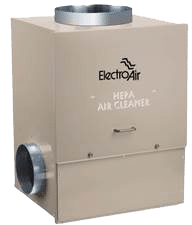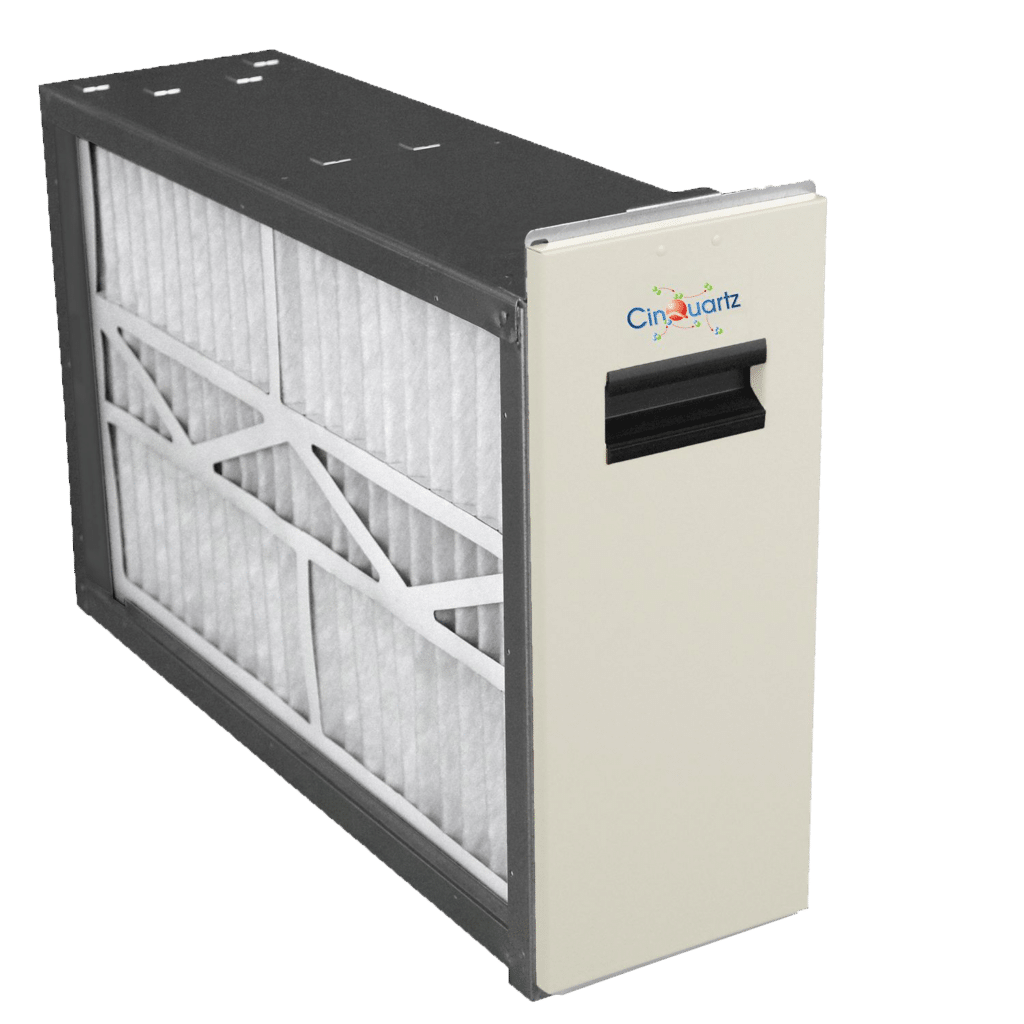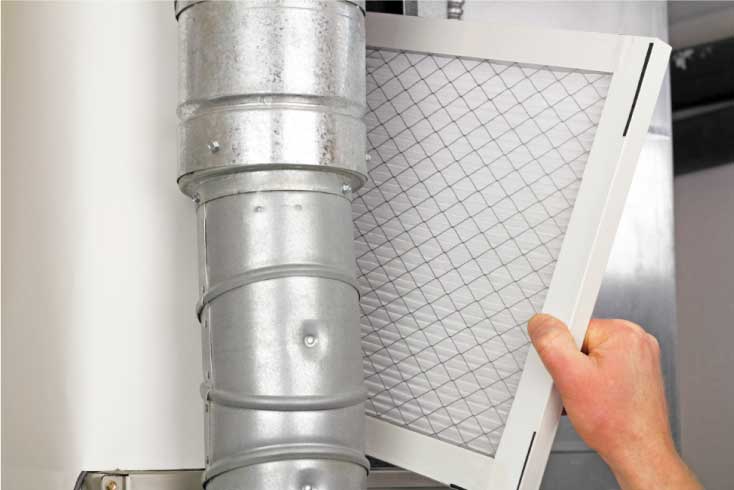A comprehensive overview of information, air purification tools and tips to improve and maintain the air quality in your home.
As the patterns of work-life continue to shift and more people find themselves working from anywhere—including, for many, their dining room tables or home office spaces—awareness is also shifting to living conditions, and specifically, the quality of the air that we breathe.
At Reliance® we know you’d be hard pressed to find an indoor space that doesn’t have at least a minimal concentration of pollutants in the air, but significant concentrations of particulate matter in the air you breathe can affect your ability to enjoy your space, as well as your comfort and quality of life.
While many factors can lead to poor air quality, including whether you live in a city or the country, how much traffic passes near your house, and even the weather, there are a broad array of air purification solutions available on the market today that can help you to immediately improve the quality of your indoor air supply, but also to keep that supply as clean and fresh as possible over time.
We’ve developed this guide to provide you with the resources necessary to understand the ins and outs of indoor air quality. Armed with the details in this guide, you’ll be better able to understand the types of air quality issues you may be experiencing in your home and the right equipment to fix them.
If in doubt, just Call on Reliance® — our Home Comfort Advisors are just a phone call away.
Air Purifiers and Covid-19
“When used properly, air cleaners, and HVAC filters can help reduce airborne contaminants including viruses in a building or small space. By itself, air cleaning or filtration is not enough to protect people from exposure to the virus that causes COVID-19. When used along with other best practices recommended by the Center for Disease Control (CDC) and others, filtration can be part of a plan to reduce the potential for airborne transmission of COVID-19 indoors.” 1
10 Questions This Guide Will Answer
- Why is indoor air quality so important?
- What are the main benefits of maintaining higher-quality air in my home?
- How do I set up my home to promote better air quality?
- Why is it important to keep my heating, ventilation and air conditioning (HVAC) system’s air filter clean?
- How can I reduce the level of pollutants in the air in my home?
- What are Volatile Organic Compounds?( VOCs?)
- Which air purification solutions are right for me?
- Which solutions does Reliance® offer to help me to improve and maintain the air quality in my home?
- What are the benefits of renting vs. buying indoor air quality solutions?
- Why should I choose Reliance for my indoor air quality needs?

Why is Indoor Air Quality So Important?
Our bodies require sufficient levels of high-quality, fresh air to function at their best.
When fine particles like pollen, pet dander, dust, cigarette smoke and Volatile Organic Compounds (VOCs) are released into the air, they decrease the air quality in the buildings in which we live, work or spend any time. This in turn can affect our health, comfort and well-being.
3 Key Benefits of Maintaining High-Quality Air in Your Home

Greater comfort and well-being
When you’ve got cleaner air in your home, you’re likely to experience fewer respiratory symptoms.

Better-performing home systems
In high concentrations, dust, debris and other pollutants can clog the equipment that filters and conditions the air in your home. This can lead to greater wear and tear, which in turn can shorten your heating and cooling equipment’s expected lifespan.

Save money every month
When your HVAC equipment pulls in cleaner air, it doesn’t have to work as hard to do its job, which means it could take less energy to run as expected.
The Importance of Keeping Your HVAC Filters Clean
- It stands to reason that if your indoor air is full of particulate matter like dust, pollen and various gaseous chemicals, so too will your HVAC filters be.
- After all, your heating and cooling equipment pulls air from indoors then processes it and returns it back into the air you breathe.
- When you have “bad air” within or just outside your home, the particulate matter gets trapped in your HVAC system’s filters.
- When those filters get too clogged up with dust, hair and other pollutants, they need to work harder, which can not only limit their effectiveness but can even shorten their lifespan.
- This is why it’s so important to check your HVAC filters for excess build-up, and based on manufacturer’s recommendation, be sure to clean and/or replace your HVAC filters as necessary.
Learn the ins and outs of furnace filters, including how to change them, in this post.
What Are Volatile Organic Compounds (VOCs)?
If you’ve purchased a new memory foam mattress, had carpeting installed in your home, or recaulked your bathtub, you’ve likely come in contact with VOCs.
Volatile Organic Compounds (VOCs) are found in many products and items used every day to build, maintain and furnish homes. This includes memory foam mattresses and pillows, carpeting and area rugs, vinyl and pressed-wood flooring, as well as some air fresheners, cleaning products, paints, caulking, and more. Once these items are brought into your home, they often release or “off-gas” VOCs into the air.2
The following steps can help you to reduce your exposure to VOCs:
- Consider purchasing low-VOC paint and furnishing options. And only buy as much paint, solvents, adhesive, caulking and other building materials as you need at any given time (unused products can “leak” VOCs into the air when stored).
- To limit exposure, store unused building materials and supplies outside of your home (e.g., in a shed or unattached garage).
- Dispose of unused building materials and supplies on a frequent basis.
- Look for solid wood items, as they often contain fewer VOCs than items made from composite wood.
- Open doors and windows when using products known to off-gas VOCs.
- Use fans to maximize the amount of air brought into your home from outside.
- Chemicals off-gas more in high-temperature and high-humidity conditions.
3 Key Strategies for Better Air Quality in Your Home
The first thing you likely think about when considering how to improve the quality of the air in your home is installing an air cleaner or purifier. And while the air purifiers, cleaners and filters on the market today could be effective tools for this purpose, it’s only one of several strategies you have at your disposal to reduce the concentration of pollutants that can cause bad air in your home.
Taken together, the following three strategies can help to get more fresh, clean air flowing in less time:
Strategy #1
Use ventilation to introduce more outdoor air inside your home
This is one of the easiest and most cost-effective strategies for decreasing indoor air pollutant concentrations: when you add ventilation—whether general or localized—you quickly improve your home’s air quality.
General Ventilation
Brings outdoor air indoors, circulates air throughout the home, and pulls polluted air outside
Methods include:
- Infiltration – casual air flow through openings, joints and cracks in walls, floors and ceiling
- Natural ventilation – flow through an open window
- Mechanical ventilation – via your HVAC system
Localized Ventilation
Removes excess moisture and pollutants that are confined to a space (e.g., a bathroom after taking a shower) before they’re able to spread to other areas of your home
Methods include:
- Infiltration – casual air flow through openings, joints and cracks in walls, floors and ceiling
- Natural ventilation – flow through an open window
Strategy #2
Control individual sources of bad air that are already in your home
Whether it’s cleaning products, appliances that release products of combustion (e.g., fireplaces, gas ranges), or even furnishings that off-gas VOCs (e.g., area rugs, foam mattresses, pressed-wood flooring), one of the most effective steps you can take to improve indoor air quality is to seek out, upgrade or eliminate individual sources of indoor air pollutants within your home.
Strategy #3
Remove airborne pollutants (a.k.a., filtering and/or cleaning)
Numerous devices and solutions (including portable air purifiers or cleaners) are capable of removing varying degrees of the airborne particles in your home’s air supply. However, they work best when you use them alongside the above two strategies. This is because air cleaners alone cannot ensure adequate air quality, particularly where significant sources of poor air are present and ventilation is insufficient.
When it comes to air filtering and cleaning devices, you have many options available to you!
Here’s a handy outline of the most common solutions on the market today:

Mechanical Air Filters
High-Efficiency Particulate Air (HEPA) filter; media air filter
What they do
Remove large particles, including dust, pollen and pet dander, by capturing them on filter materials

Electronic Air Cleaners
Electrostatic
Air Filter
What they do
Generate charged particles that trap or attach to pollutants in order to remove them from the air

Disinfection Systems
Ultraviolet (UV) germicidal lamps or lights; ion generators/air ionizer
What they do
Alter the chemical composition or otherwise damage the genetic material inside bacteria, viruses and moulds, thereby inactivating or killing them
Indoor Air Quality Solutions
At Reliance, we offer an array of products that can help to improve the quality of the air in your home.
Consider the following options—which work with your existing HVAC or can be added to a new heating and cooling system—to get and maintain better air quality in your home.

UV Light System
Mounts in the air duct of your HVAC system; UV technology attacks microorganisms on a molecular level to help prevent mould and bacteria from multiplying on your AC coil
Honeywell Home Ultraviolet Light – SmartLamp control determines optimal UV lamp usage, while direct-to-coil UV-C light can prevent bacteria and mould from building up on your HVAC system’s coils
Reduces the likelihood of microorganism build-up in your HVAC system
Honeywell Home Ultraviolet Light – SmartLamp control determines optimal UV lamp usage, while direct-to-coil UV-C light can prevent bacteria and mould from building up on your HVAC system’s coils
Whole-Home HEPA Filters
When connected to your home’s air return, capable of removing 99.97% of particles 0.3 microns and larger, such as household dust, mites, pollen, mould spores, pet dander, cooking smoke and grease, and more
Can offer relief from allergies and asthma while providing a more comfortable living environment, year-round
Electro-Air Whole-House True HEPA Air Cleaner – small but mighty, with over 100 ft2 of collection surface area; offers both a carbon prefilter and after-filter to remove lint, dust, unpleasant odours and gases (including VOCs) from air returns of your HVAC system


Heat Recovery Ventilator (HRV) and Energy Recovery Ventilator (ERV)
Supply clean, fresh air, while also recovering energy and humidity (ERV only) from exhaust air
Balanced heat recovery and airflow, for higher levels of heat and energy transfer
Lifebreath Residential HRVs – designed to bring fresh air into a building while exhausting an equal amount of stale air outside
Electrostatic Air Filters
Known as washable or reusable; self-charging electrostatic cotton or paper fibres attract and trap small particles like dust and pollen
Affordable in standard sizes; a good choice for homes with children, pets or smokers; washable filters have multiple layers to capture contaminants
DAFCO Electrostatic Filters – easy to change and available in a variety of sizes to suit different HVAC systems


Whole-Home HEPA Filters
When connected to your home’s air return, capable of removing 99.97% of particles 0.3 microns and larger, such as household dust, mites, pollen, mould spores, pet dander, cooking smoke and grease, and more
Can offer relief from allergies and asthma while providing a more comfortable living environment, year-round
Electro-Air Whole-House True HEPA Air Cleaner – small but mighty, with over 100 ft2 of collection surface area; offers both a carbon prefilter and after-filter to remove lint, dust, unpleasant odours and gases (including VOCs) from air returns of your HVAC system
Whole-Home Humidifier
Adds moisture only when it’s needed and limits humidity to the level you select
Get relief from dry skin and sinus discomfort, while also helping to keep your energy bills in check (low humidity in the air makes the temperature feel colder, which can lead to you turning up the heat even more!)
Plus: Protect wood and other surfaces in your home from cracking and other damage caused by over-dry air
DS-PFT Pro-Series Pulse Flow-Through Humidifier – quiet and reliable, with patented electronic flow control that delivers comfort and performance with less water going down the drain

Humidifiers and the Covid-19 Pandemic
According the Public Health Agency of Canada , while humidifiers cannot remove viruses like coronavirus from the air, they could help reduce the time that the virus droplets remain in the air. Maintaining an optimal humidity level is therefore key. This chart is a handy guide to how high and low to set your humidity – note if you have the Carrier Infinity System Control Thermostat, it will do this automatically. Based on the chart below, Health Canada (2007) recommends that the relative humidity in your home is kept below 50% in the summer and between 30-35% in the winter .
Can’t tell your HEPA from your UV? No problem! Our Home Comfort Advisors are specially trained to help you choose the best solution for your specific needs and budget.
To Rent or to Buy: Determining the Right Choice for Your Home
When you invest in a Reliance Indoor Air Quality System, you’re investing in your family’s wellbeing.
If you’re considering whether to rent or buy, here are a few things to keep in mind:
When You Rent
- Hassle-free peace of mind, year-round
- Pay for your system through affordable monthly payments, which can simplify your household budget
- Rental fees cover servicing (which help to keep your system in tip-top shape) and most repairs
- Buy out your equipment at any time
- Take advantage of available promotions and offers
When You Buy
- Involves an upfront cost, but minimal ongoing investment (aside from servicing or any repairs that are outside of warranty*)
- Option to purchase a protection plan for any unexpected maintenance and repairs
- Take advantage of available promotions and offers
*Warranty includes up to 10 years, parts and labour.
Schedule a consultation today!
One of our Home Comfort Advisors will walk you through all of your air quality options and help you to
make the right choice for your home and budget.
Why Choose Reliance for Your Indoor Air Quality Needs?
Simply put: We’ve got the systems and services you need to enjoy cleaner air, easily and cost-effectively, in your home!
With Reliance’s indoor air quality options—ranging from basic filtration to products that leverage technology used by professionals in medical settings—plus skilled technicians to guide you every step of the way, you can be confident that you’ll find the right solution for your specific needs and budget.
Take advantage of these benefits when you
Call on Reliance to improve your indoor air quality:
- Receive comprehensive system recommendations and advice from Home Comfort Advisors
- Choose from a wide selection of high-quality products, including equipment that works with your existing HVAC system or can be bundled with a new heating and cooling system
- Rental packages include consultation, full equipment installation, servicing and most repairs for as long as you remain a rental customer.



